Bird R.B., Stewart W.E., Lightfoot E.N. Transport Phenomena
Подождите немного. Документ загружается.

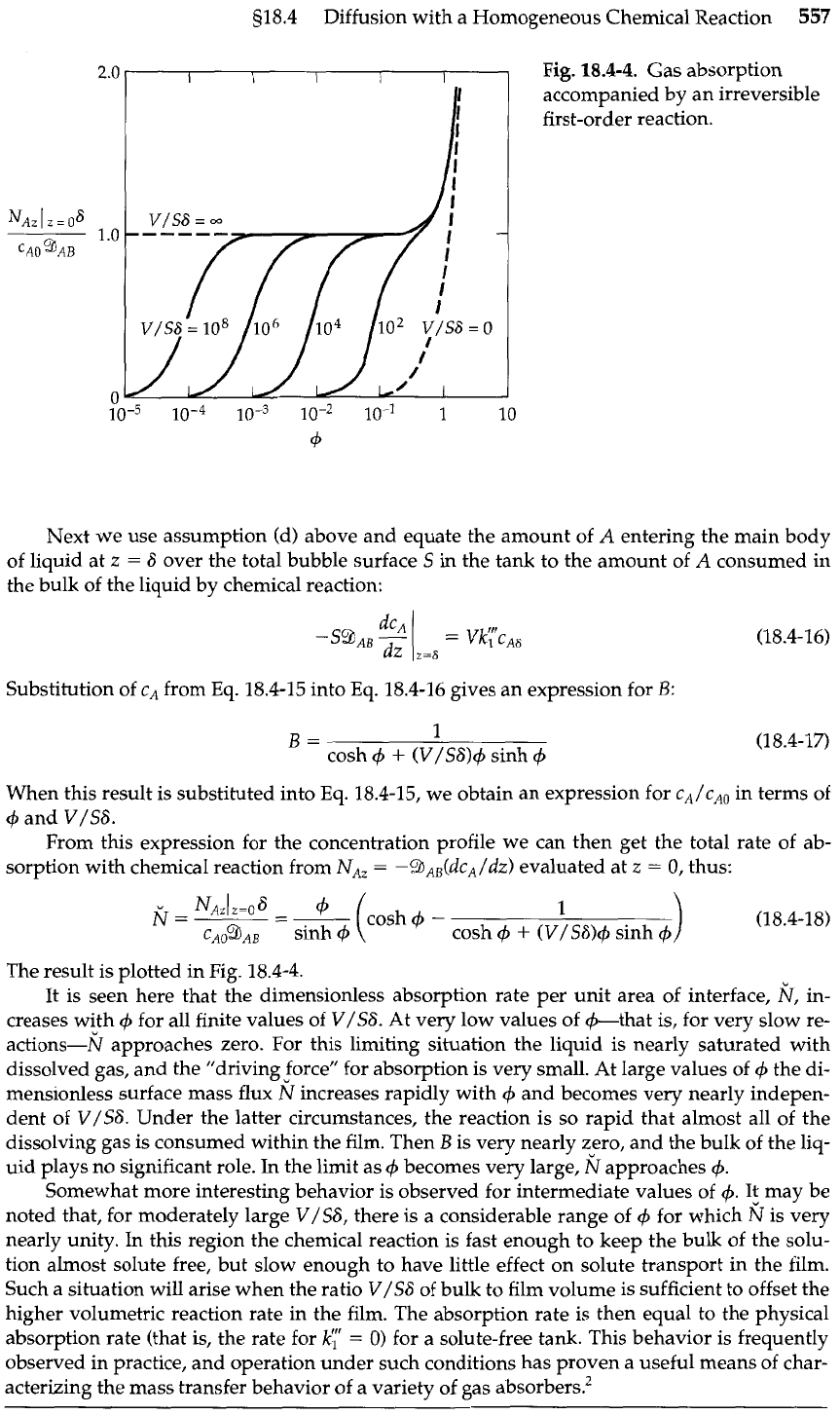
918.4 Diffusion with a Homogeneous Chemical Reaction
557
Fig.
18.4-4.
Gas absorption
accompanied by an irreversible
first-order reaction.
Next we use assumption (d) above and equate the amount of
A
entering the main body
of liquid at
z
=
S over the total bubble surface
S
in the tank to the amount of
A
consumed in
the bulk of the liquid by chemical reaction:
Substitution of cA from Eq. 18.4-15 into Eq. 18.4-16 gives an expression for
B:
B
=
1
cash
4
+
(V/SS)Q, sinh
+
When this result is substituted into Eq. 18.4-15, we obtain an expression for cA/cAO in terms of
Q,
and V/SS.
From this expression for the concentration profile we can then get the total rate of ab-
sorption with chemical reaction from NA,
=
-91AB(dcA/dz) evaluated at
z
=
0, thus:
3=
N~zlz=o~
-
+
cosh
+
-
1
cA091AB
-
-
sinh
Q,
(
cosh
+
(V/SS)4 sinh
+
)
(18.4-18)
The result is plotted in Fig. 18.4-4.
It is seen here that the dimensionless absorption rate per unit area of interface,
I?,
in-
creases with
+
for all finite values of V/SS. At very low values of +-that is, for very slow re-
actions-I? approaches zero. For this limiting situation the liquid
is
nearly saturated with
dissolved gas, and the "driving force" for absorption is very small. At large values of
4
the di-
mensionless surface mass flux
N
increases rapidly with
4
and becomes very nearly indepen-
dent of V/SS. Under the latter circumstances, the reaction is so rapid that almost all of the
dissolving gas is consumed within the film. Then
B
is very nearly zero, and the bulk of the liq-
uid plays no significant role. In the limit as
4
becomes very large,
I?
approaches
+.
Somewhat more interesting behavior is observed for intermediate values of
+.
It may be
noted that, for moderately large V/SS, there is a considerable range of
+
for which
fi
is very
nearly unity. In this region the chemical reaction is fast enough to keep the bulk of the solu-
tion almost solute free, but slow enough to have little effect on solute transport in the film.
Such a situation will arise when the ratio
V/SS
of bulk to film volume is sufficient to offset the
higher volumetric reaction rate in the film. The absorption rate is then equal to the physical
absorption rate (that is, the rate for
k',"
=
0) for a solute-free tank. This behavior is frequently
observed in practice, and operation under such conditions has proven a useful means of char-
acterizing the mass transfer behavior of a variety of gas absorbers.'
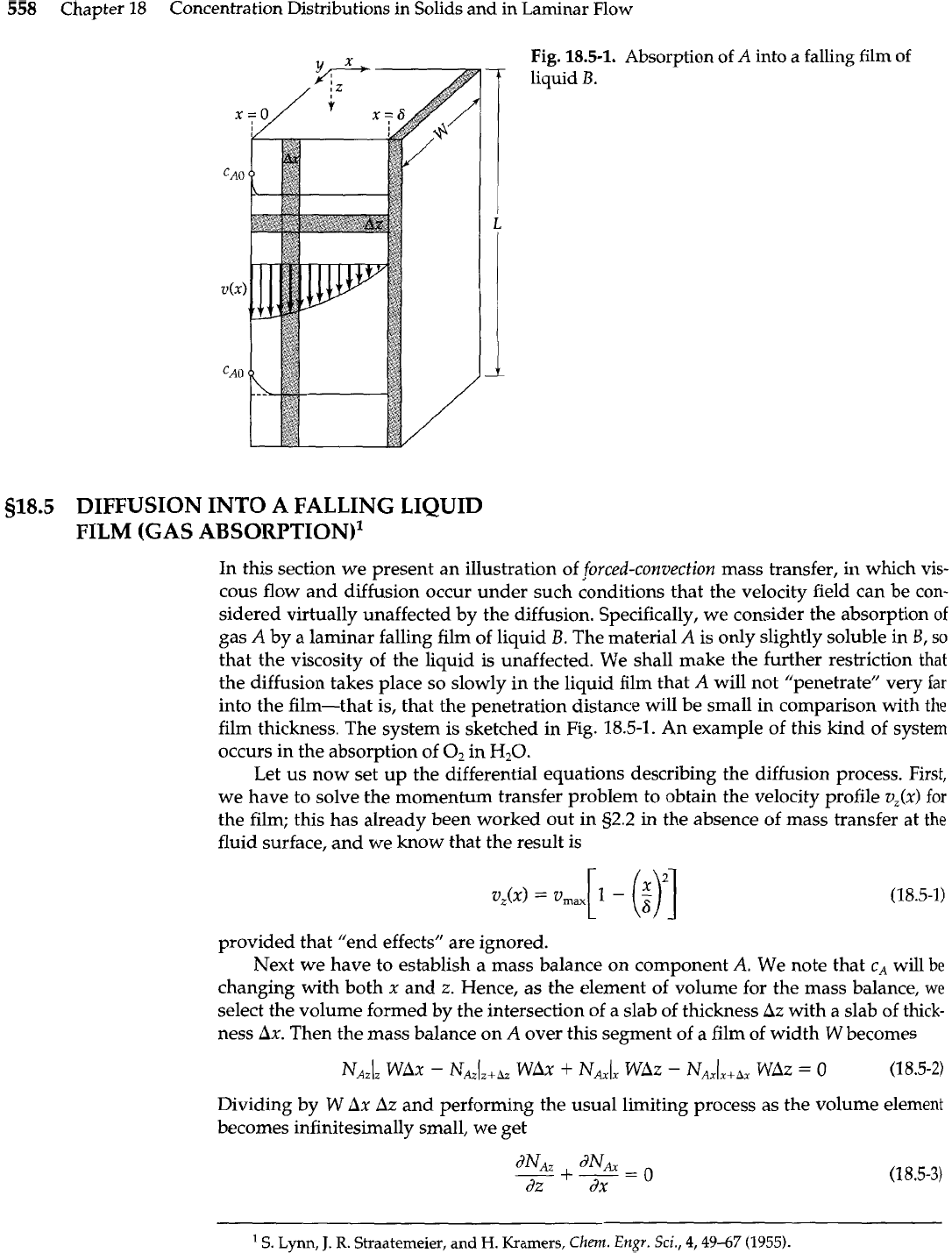
558
Chapter 18 Concentration Distributions in Solids and in Laminar Flow
Fig.
18.5-1.
Absorption of
A
into a falling
film
of
liquid
B.
518.5
DIFFUSION INTO A FALLING LIQUID
FILM (GAS ABSORPTION)'
In this section we present an illustration of
forced-convection
mass transfer, in which vis-
cous flow and diffusion occur under such conditions that the velocity field can be con-
sidered virtually unaffected by the diffusion. Specifically, we consider the absorption of
gas
A
by a laminar falling film of liquid
B.
The material
A
is only slightly soluble in
B,
so
that the viscosity of the liquid is unaffected. We shall make the further restriction that
the diffusion takes place so slowly in the liquid film that
A
will not "penetrate" very far
into the film-that is, that the penetration distance will be small in comparison with
the
film thickness. The system is sketched in
Fig.
18.5-1. An example of this kind of system
occurs in the absorption of
0,
in
H,O.
Let us now set up the differential equations describing the diffusion process.
First,
we have to solve the momentum transfer problem to obtain the velocity profile
vz(x)
for
the film; this has already been worked out in
52.2
in the absence of mass transfer at
the
fluid surface, and we know that the result is
provided that "end effects" are ignored.
Next we have to establish a mass balance on component
A.
We note that
cA
will
be
changing with both
x
and
z.
Hence, as the element of volume for the mass balance,
we
select the volume formed
by
the intersection of a slab of thickness
Az
with a slab of thick-
ness
Ax.
Then the mass balance on
A
over this segment of a film of width
W
becomes
Dividing by
W
Ax
Az
and performing the usual limiting process as the volume element
becomes infinitesimally small, we get
S.
Lynn,
J.
R.
Straatemeier,
and
H.
Kramers,
Chem.
Engr.
Sci.,
4,4947
(1955).
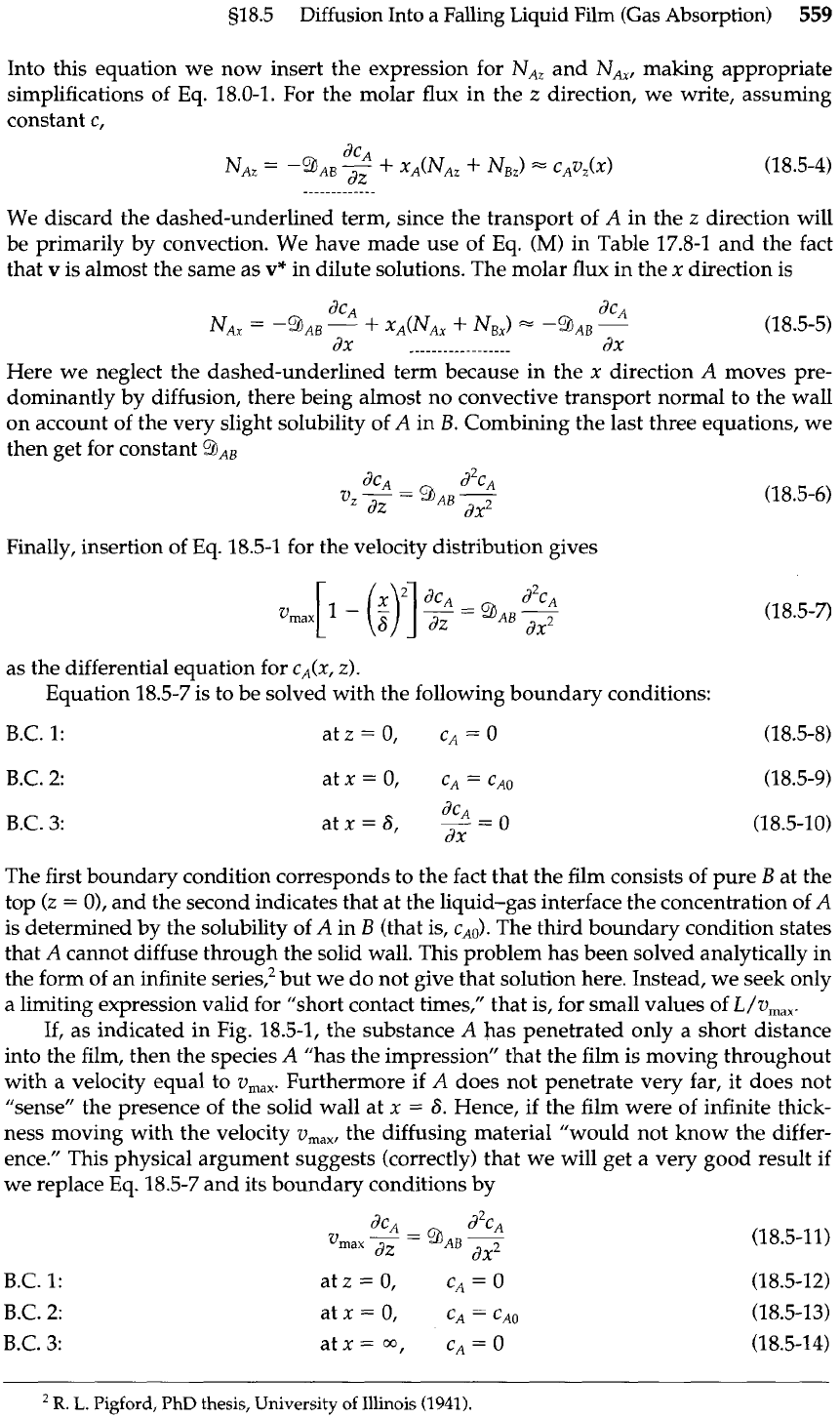
s18.5
Diffusion Into a Falling Liquid Film (Gas Absorption)
559
Into this equation we now insert the expression for NA, and NA,, making appropriate
simplifications of Eq. 18.0-1. For the molar flux in the
z
direction, we write, assuming
constant
c,
We discard the dashed-underlined term, since the transport of
A
in the
z
direction will
be primarily by convection. We have made use of Eq.
(M)
in Table 17.8-1 and the fact
that
v
is almost the same as
vW
in dilute solutions. The molar flux in the
x
direction is
~CA
~CA
NAx
=
-
+
xA(NAx
+
NBx) -QAB
--
(18.5-5)
dx
-----------..-----
dx
Here we neglect the dashed-underlined term because in the x direction
A
moves pre-
dominantly by diffusion, there being almost no convective transport normal to the wall
on account of the very slight solubility of
A
in
B.
Combining the last three equations, we
then get for constant
9,,
Finally, insertion of
Eq.
18.5-1 for the velocity distribution gives
as the differential equation for cA(x, z).
Equation 18.5-7 is to be solved with the following boundary conditions:
B.C.
1:
atz=O, cA=O (18.5-8)
B.C.
2:
at
x
=
0,
c,
=
c,, (18.5-9)
B.C.
3:
~CA
atx=6,
-=O
dx
(18.5-10)
The first boundary condition corresponds to the fact that the film consists of pure
B
at the
top
(Z
=
O),
and the second indicates that at the liquid-gas interface the concentration of
A
is determined
by
the solubility of
A
in
B
(that is, cAo). The third boundary condition states
that
A
cannot diffuse through the solid wall. This problem has been solved analytically in
the form of an infinite series? but we do not give that solution here. Instead, we seek only
a limiting expression valid for "short contact times," that is, for small values of
L/vm,,.
If, as indicated in Fig. 18.5-1, the substance
A
has penetrated only a short distance
into the film, then the species
A
"has the impression" that the film is moving throughout
with
a
velocity equal to
v,,,.
Furthermore if
A
does not penetrate very far, it does not
"sense" the presence of the solid wall at
x
=
6. Hence, if the film were of infinite thick-
ness moving with the velocity
v,,,,
the diffusing material "would not know the differ-
ence." This physical argument suggests (correctly) that we will get a very good result if
we replace
Eq.
18.5-7 and its boundary conditions by
B.C. 1:
B.C.
2:
B.C.
3:
R.
L.
Pigford, PhD
thesis,
University
of
Illinois
(1941).
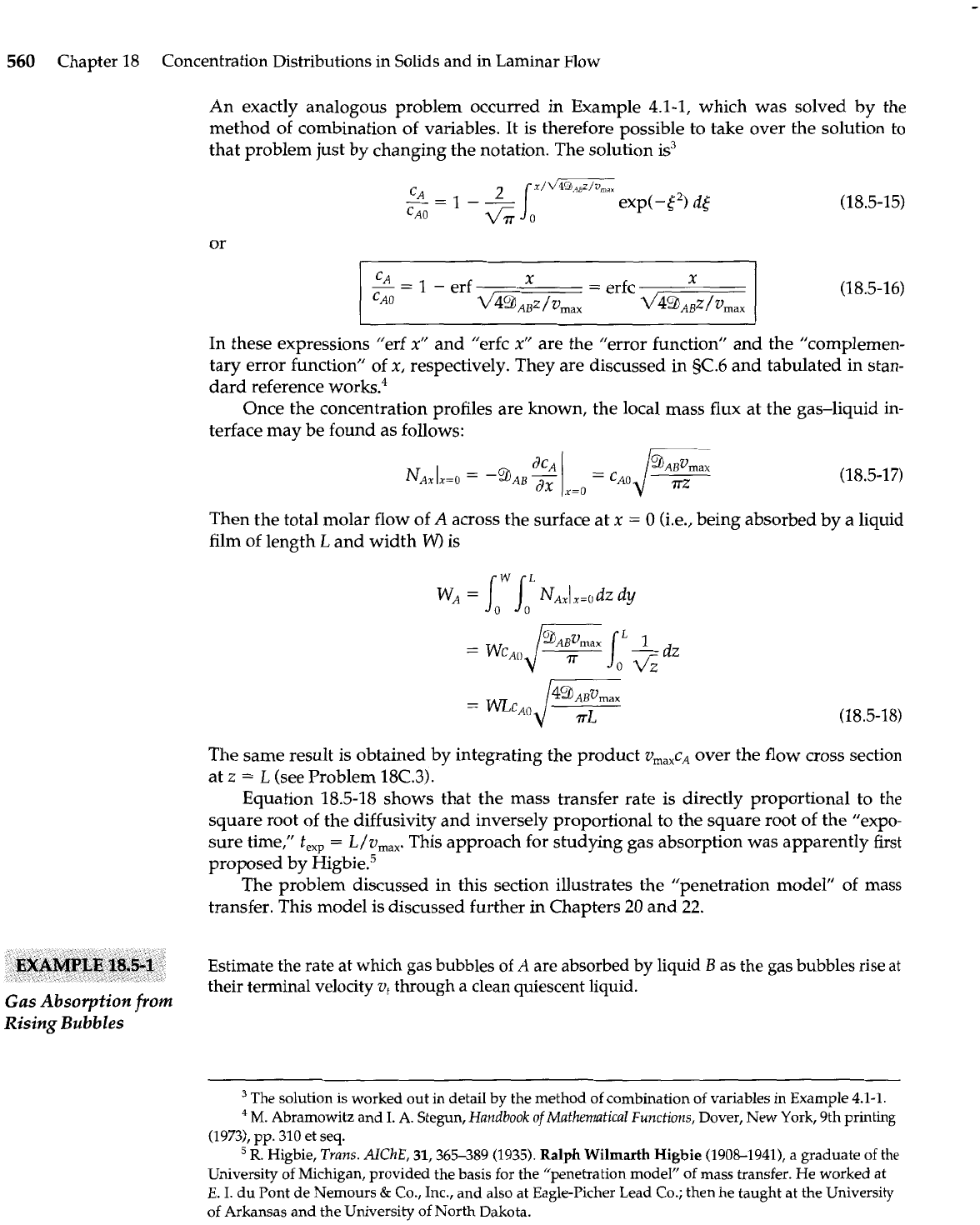
560
Chapter 18 Concentration Distributions in Solids and in Laminar Flow
An exactly analogous problem occurred in Example 4.1-1, which was solved by the
method of combination of variables. It is therefore possible to take over the solution to
that problem just by changing the notation. The solution is"
Then the total molar flow of
A
across the surface at
x
=
0
(i.e., being absorbed by a liquid
film of length
L
and width
W)
is
C
A
X
X
-
=
1
-
erf
=
erfc
c~~
d49ABz/vrnax v4%ABz/vmax
The same result is obtained by integrating the product
vm,,cA
over the flow cross section
at
z
=
L
(see Problem 18C.3).
Equation 18.5-18 shows that the mass transfer rate is directly proportional to the
square root of the diffusivity and inversely proportional to the square root of the "expo-
sure time,"
texP
=
L/vrnax.
This approach for studying gas absorption was apparently first
proposed by Higbie.5
The problem discussed in this section illustrates the "penetration model" of mass
transfer. This model is discussed further in Chapters
20
and
22.
(18.5-16)
Estimate the rate at which gas bubbles of
A
are absorbed
by
liquid
B
as the gas bubbles rise
at
their terminal velocity
v,
through a clean quiescent liquid.
Gas Absorption from
Rising Bubbles
In these expressions "erf
x"
and "erfc
x"
are the "error function" and the "complemen-
tary error function" of x, respectively. They are discussed in
gC.6
and tabulated in stan-
dard reference works4
Once the concentration profiles are known, the local mass flux at the gas-liquid in-
terface may be found as follows:
The solution is worked out in detail by the method of combination of variables in Example 4.1-1.
M.
Abramowitz and I. A. Stegun,
Handbook ofMathematica1 Functions,
Dover, New York, 9th printing
(1973),
pp.
310 et seq.
R.
Higbie,
Trans.
AIChE,
31,365-389 (1935). Ralph Wilmarth Higbie (190&1941), a graduate
of
the
University of Michigan, provided the basis for the "penetration model" of mass transfer. He worked at
E.
I. du Pont de Nemours
&
Co., Inc., and also at Eagle-Picher Lead Co.; then he taught at the University
of Arkansas and the University of North Dakota.
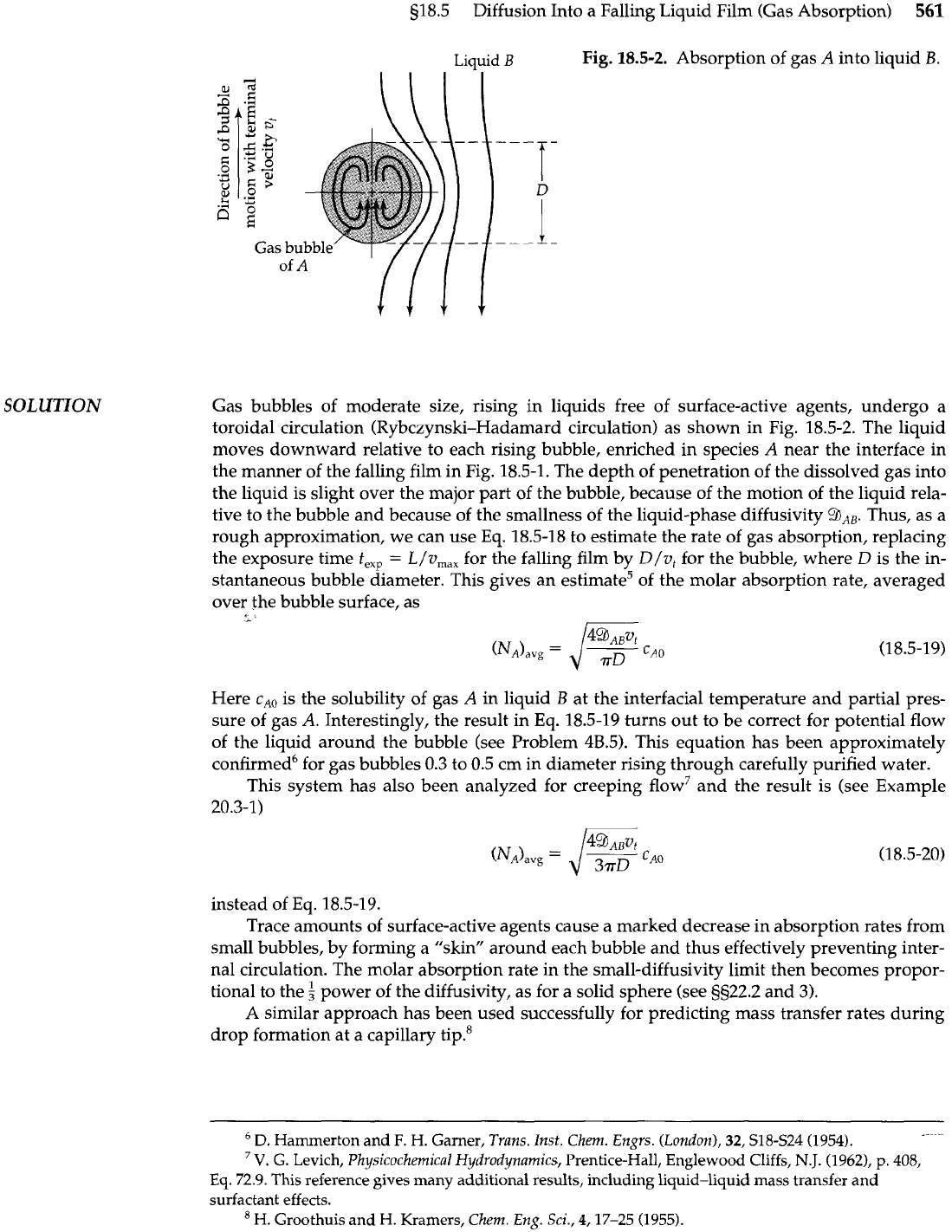
518.5 Diffusion Into a Falling Liquid Film (Gas Absorption)
561
SOLUTION
Liquid
B
Fig.
18.5-2.
Absorption of gas
A
into liquid
B.
3
Gas bubbles of moderate size, rising in liquids free of surface-active agents, undergo a
toroidal circulation (Rybczynski-Hadamard circulation) as shown in Fig. 18.5-2. The liquid
moves downward relative to each rising bubble, enriched in species
A
near the interface in
the manner of the falling film in Fig. 18.5-1. The depth of penetration of the dissolved gas into
the liquid is slight over the major part of the bubble, because of the motion of the liquid rela-
tive to the bubble and because of the smallness of the liquid-phase diffusivity
9AB.
Thus, as a
rough approximation, we can use Eq. 18.5-18 to estimate the rate of gas absorption, replacing
the exposure time
t,,,
=
L/v,,,
for the falling film by
D/v,
for the bubble, where
D
is the in-
stantaneous bubble diameter. This gives an estimate5 of the molar absorption rate, averaged
over the bubble surface, as
I
Here
cAO
is the solubility of gas
A
in liquid
B
at the interfacial temperature and partial pres-
sure of gas
A.
Interestingly, the result in
Eq.
18.5-19 turns out to be correct for potential flow
of the liquid around the bubble (see Problem 4B.5). This equation has been approximately
confirmed6 for gas bubbles 0.3 to 0.5 cm in diameter rising through carefully purified water.
This system has also been analyzed for creeping flow7 and the result is (see Example
20.3-1)
instead of Eq. 18.5-19.
Trace amounts of surface-active agents cause a marked decrease in absorption rates from
small bubbles, by forming a "skin" around each bubble and thus effectively preventing inter-
nal circulation. The molar absorption rate in the small-diffusivity limit then becomes propor-
tional to the
$
power of the diffusivity, as for a solid sphere (see $3522.2 and
3).
A similar approach has been used successfully for predicting mass transfer rates during
drop formation at
a
capillary tip.8
D.
Hammerton and
F.
H.
Garner,
Trans. Inst.
Chem.
Engrs.
(London),
32,
S18-524 (1954).
V.
G.
Levich,
Pkysicockemical Hydrodynamics,
Prentice-Hall, Englewood Cliffs,
N.J.
(1962),
p.
408,
Eq.
72.9.
This reference gives many additional results, including liquid-liquid mass transfer and
surfactant effects.
H.
Groothuis and
H.
Kramers,
Chem.
Eng.
Sci., 4,17-25 (1955).
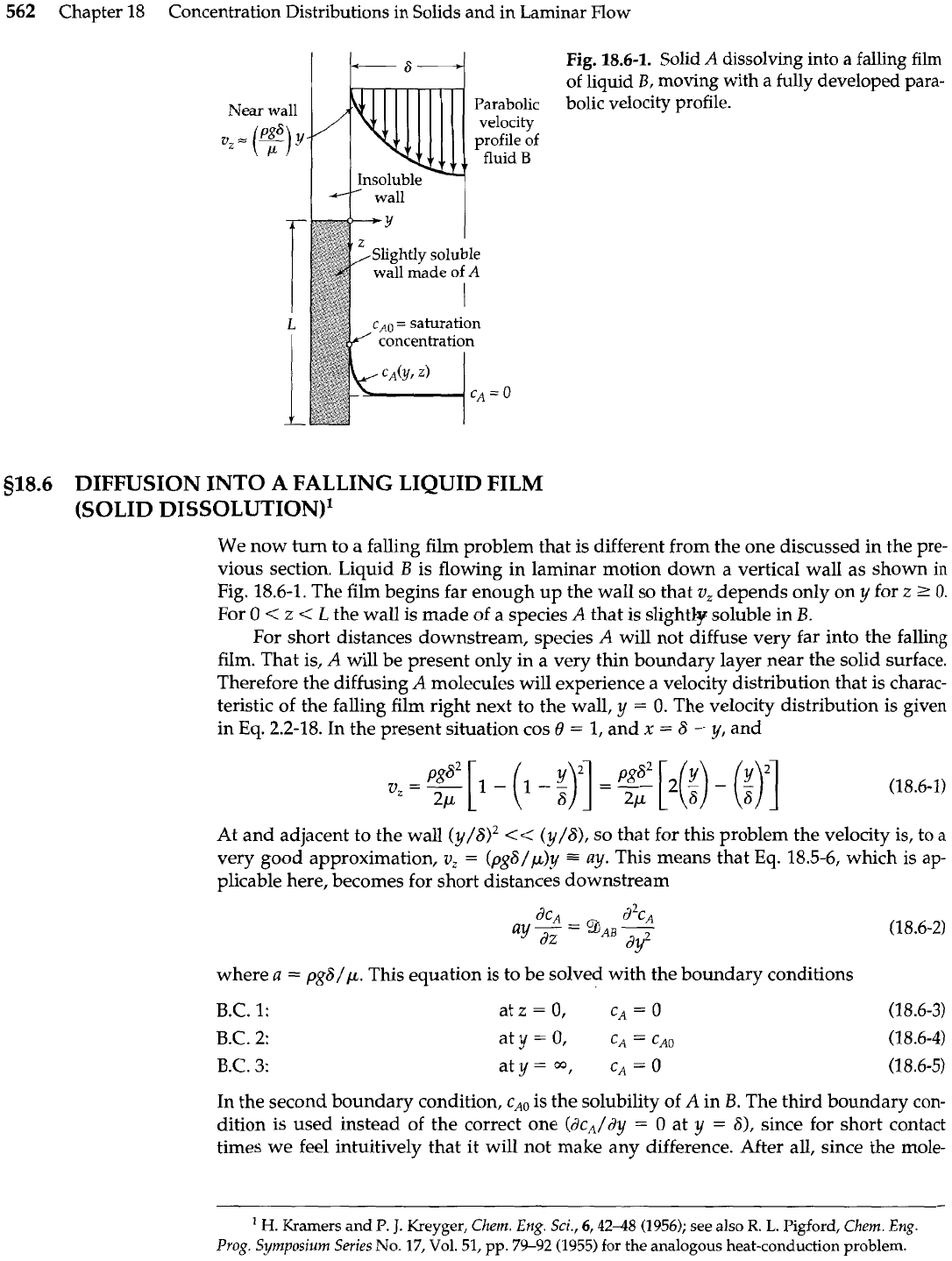
562
Chapter
18
Concentration Distributions in Solids and in Laminar Flow
Fig.
18.6-1.
Solid
A
dissolving into a falling film
of liquid
B,
moving with a
fully
developed para-
Near wall Parabolic
bolic velocity profile.
velocity
profile of
fluid
B
Slightly soluble
wall made of
A
L
I
CA~
=
saturation
concentration
918.6
DIFFUSION INTO
A
FALLING LIQUID FILM
(SOLID DISSOLUTION)1
We now turn to a falling film problem that is different from the one discussed in the pre-
vious section. Liquid
B
is flowing in laminar motion down a vertical wall as shown in
Fig. 18.6-1. The film begins far enough up the wall so that
v,
depends only on y for
z
0.
For
0
<
z
<
L
the wall is made of a species
A
that is slightly soluble in
B.
For short distances downstream, species
A
will not diffuse very far into the falling
film. That is,
A
will be present only in a very thin boundary layer near the solid surface.
Therefore the diffusing
A
molecules will experience a velocity distribution that is charac-
teristic of the falling film right next to the wall,
y
=
0.
The velocity distribution is given
in
Eq.
2.2-18. In the present situation cos
8
=
1, and
x
=
6
-
y,
and
At and adjacent to the wall (~/6)~
<<
(y/6),
so that for this problem the velocity is, to a
very good approximation,
v,
=
(pg6/p)y
=
ay.
This means that
Eq.
18.5-6, which is ap-
plicable here, becomes for short distances downstream
~CA
d2cA
ay-
=
9,,-
a2
ay2
where
a
=
pg6/p. This equation is to be solved with the boundary conditions
B.C.
1:
B.C.
2:
B.C.
3:
In the second boundary condition,
c,,
is the solubility of
A
in
B.
The third boundary con-
dition is used instead of the correct one (dc,/dy
=
0
at
y
=
6),
since for short contact
times we feel intuitively that it will not make any difference. After all, since the mole-
H.
Kramers and
P.
J.
Kreyger,
Chem.
Eng.
Sci., 6,4248
(1956); see also
R.
L.
Pigford,
Chem.
Eng.
Puog.
Symposium Series
No.
17,
Vol.
51,
pp.
79-92
(1955) for the analogous heat-conduction problem.
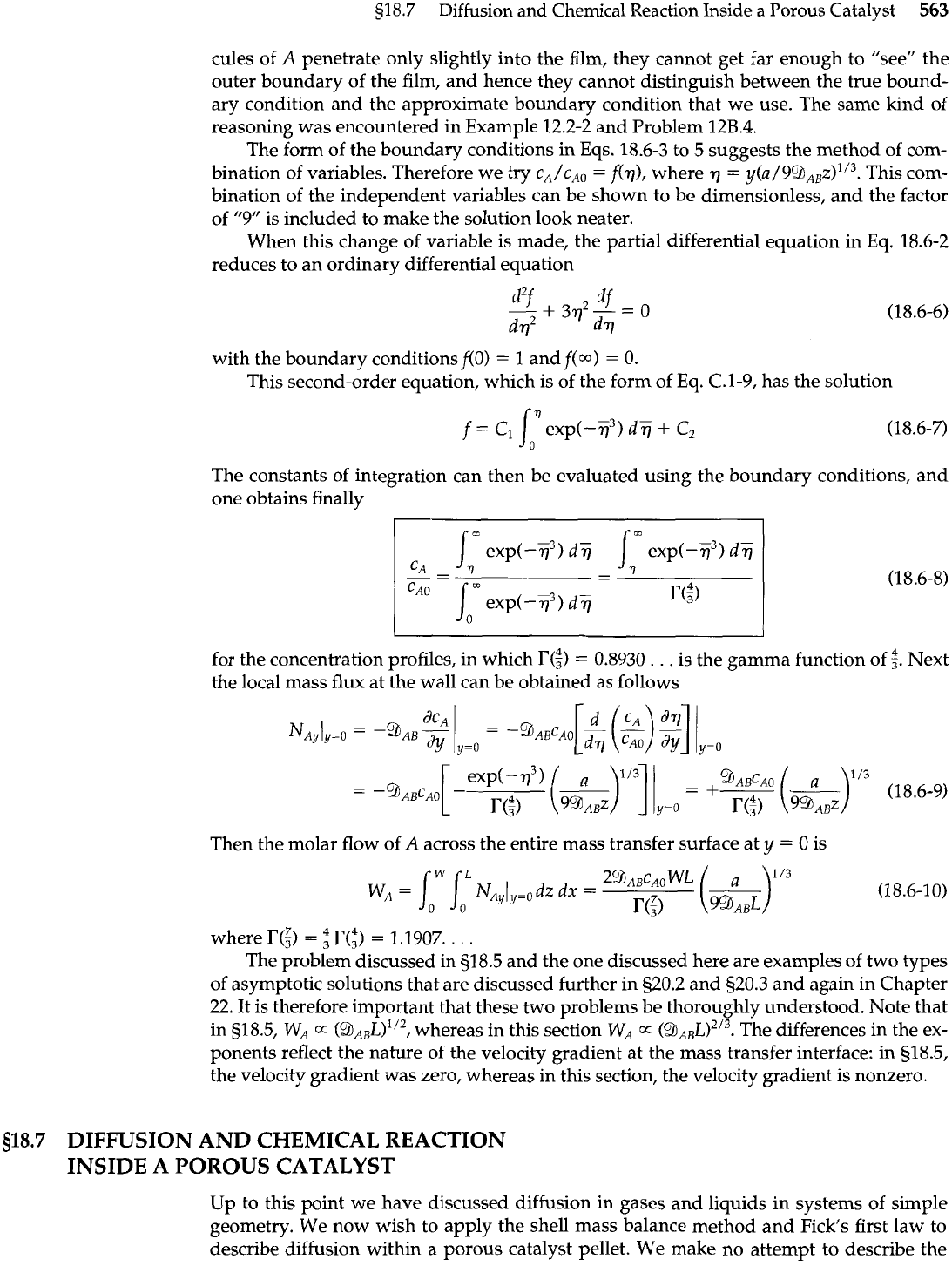
518.7 Diffusion and Chemical Reaction Inside a Porous Catalyst
563
cules of
A
penetrate only slightly into the film, they cannot get far enough to "see" the
outer boundary of the film, and hence they cannot distinguish between the true bound-
ary condition and the approximate boundary condition that we use. The same kind of
reasoning was encountered in Example 12.2-2 and Problem
12B.4.
The form of the boundary conditions in Eqs. 18.6-3 to 5 suggests the method of com-
bination of variables. Therefore we try
cA/cAO
=
f($, where
7
=
~(a/99~,z)'/~.
This com-
bination of the independent variables can be shown to be dimensionless, and the factor
of
"9"
is included to make the solution look neater.
When this change of variable is made, the partial differential equation in Eq. 18.6-2
reduces to an ordinary differential equation
with the boundary conditions
f(0)
=
1 and
f(w)
=
0.
This second-order equation, which is of the form of Eq. C.1-9, has the solution
The constants of integration can then be evaluated using the boundary conditions, and
one obtains finally
I
I
for the concentration profiles, in which
~(2)
=
0.8930
.
.
.
is the gamma function of
$.
Next
the local mass flux at the wall can be obtained as follows
Then the molar flow of
A
across the entire mass transfer surface at
y
=
0
is
where
I?($)
=
4
r($)
=
1.1907.
. .
.
The problem discussed in 518.5 and the one discussed here are examples of two types
of asymptotic solutions that are discussed further in 920.2 and 520.3 and again in Chapter
22.
It is therefore important that these two problems be thoroughly understood. Note that
in s18.5,
wA
K
(QAB~)1/2,
whereas in this section
wA
cc
(%AB~)2'3.
The differences in the ex-
ponents reflect the nature of the velocity gradient at the mass transfer interface: in 518.5,
the velocity gradient was zero, whereas in this section, the velocity gradient is nonzero.
518.7
DIFFUSION AND CHEMICAL REACTION
INSIDE A POROUS CATALYST
Up to this point we have discussed diffusion in gases and liquids in systems of simple
geometry. We now wish to apply the shell mass balance method and Fick's first law to
describe diffusion within
a
porous catalyst pellet. We make no attempt to describe the
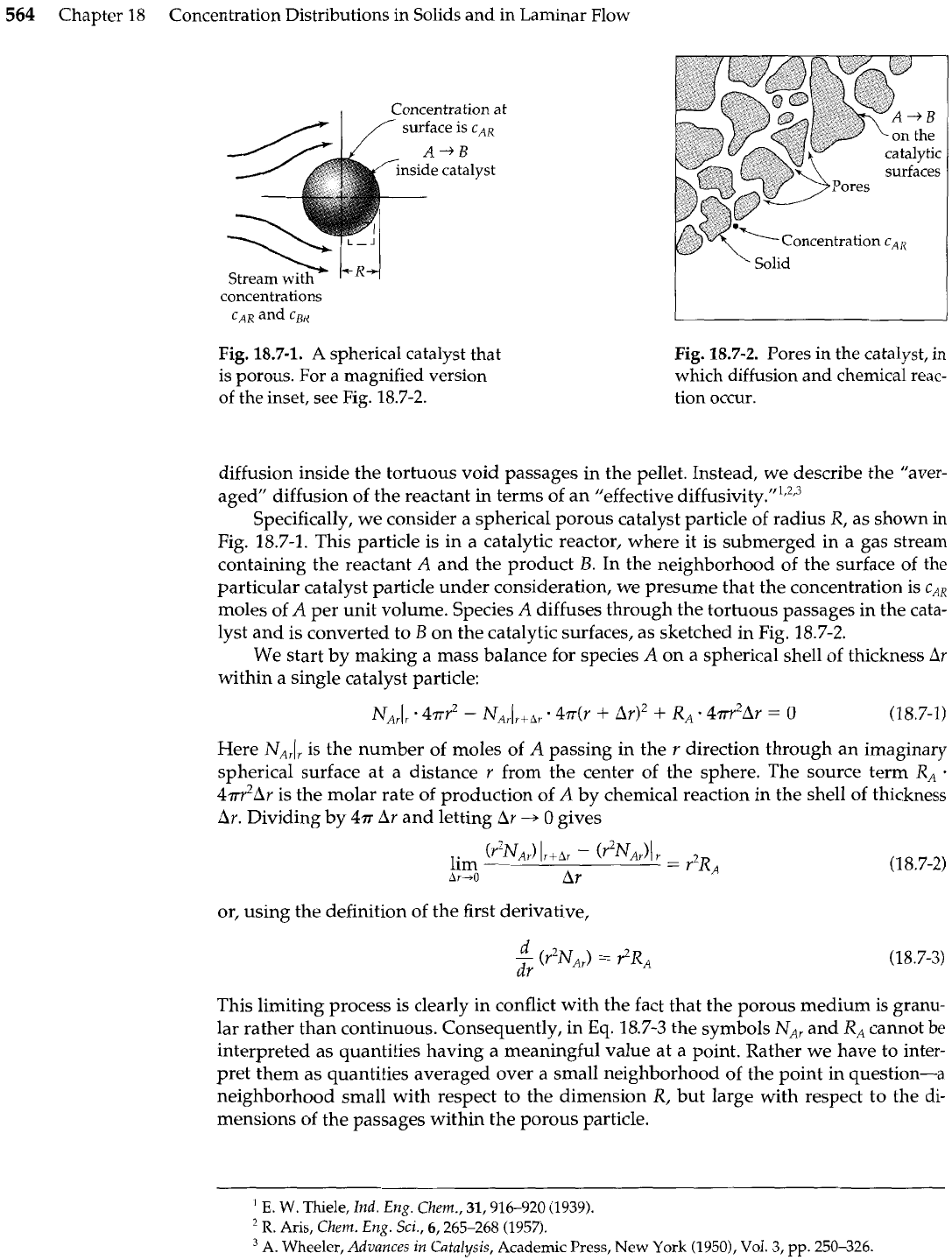
564
Chapter
18
Concentration Distributions in Solids and in Laminar Flow
I
Concentration
at
concentrations
CAR
and
CB
K
CAR
lyst
Fig.
18.7-1.
A
spherical catalyst that
is porous. For a magnified version
of
the inset, see Fig.
18.7-2.
r
\
Solid
Fig.
18.7-2.
Pores in the catalyst, in
which diffusion and chemical reac-
tion occur.
diffusion inside the tortuous void passages in the pellet. Instead, we describe the "aver-
aged diffusion of the reactant in terms of an "effective diff~sivity."',~,~
Specifically, we consider a spherical porous catalyst particle of radius R, as shown in
Fig. 18.7-1. This particle is in
a
catalytic reactor, where it is submerged in a gas stream
containing the reactant
A
and the product
B.
In the neighborhood of the surface of the
particular catalyst particle under consideration, we presume that the concentration is
cA,
moles of
A
per unit volume. Species
A
diffuses through the tortuous passages in the cata-
lyst and is converted to
B
on the catalytic surfaces, as sketched in Fig. 18.7-2.
We start by making a mass balance for species
A
on a spherical shell of thickness
Ar
within a single catalyst particle:
Here
NAr(,
is the number of moles of
A
passing in the
r
direction through an imaginary
spherical surface at a distance
r
from the center of the sphere. The source term
X,
.
4m2Ar
is the molar rate of production of
A
by chemical reaction in the shell of thickness
Ar.
Dividing by
437
Ar
and letting
Ar
-+
0
gives
or, using the definition of the first derivative,
This limiting process is clearly in conflict with the fact that the porous medium is granu-
lar rather than continuous. Consequently, in
Eq.
18.7-3 the symbols
NAu
and RA cannot
be
interpreted as quantities having a meaningful value at a point. Rather we have to inter-
pret them as quantities averaged over a small neighborhood of the point in question-a
neighborhood small with respect to the dimension R, but large with respect to the
di-
mensions of the passages within the porous particle.
'
E.
W.
Thiele,
Ind.
Eng.
Chem.,
31,916-920 (1939).
'
R.
Aris,
Chem.
Eng.
Sci.,
6,265-268 (1957).
A. Wheeler,
Advances
in
Catalysis,
Academic Press, New York
(1950),
Vol.
3, pp.
250-326.
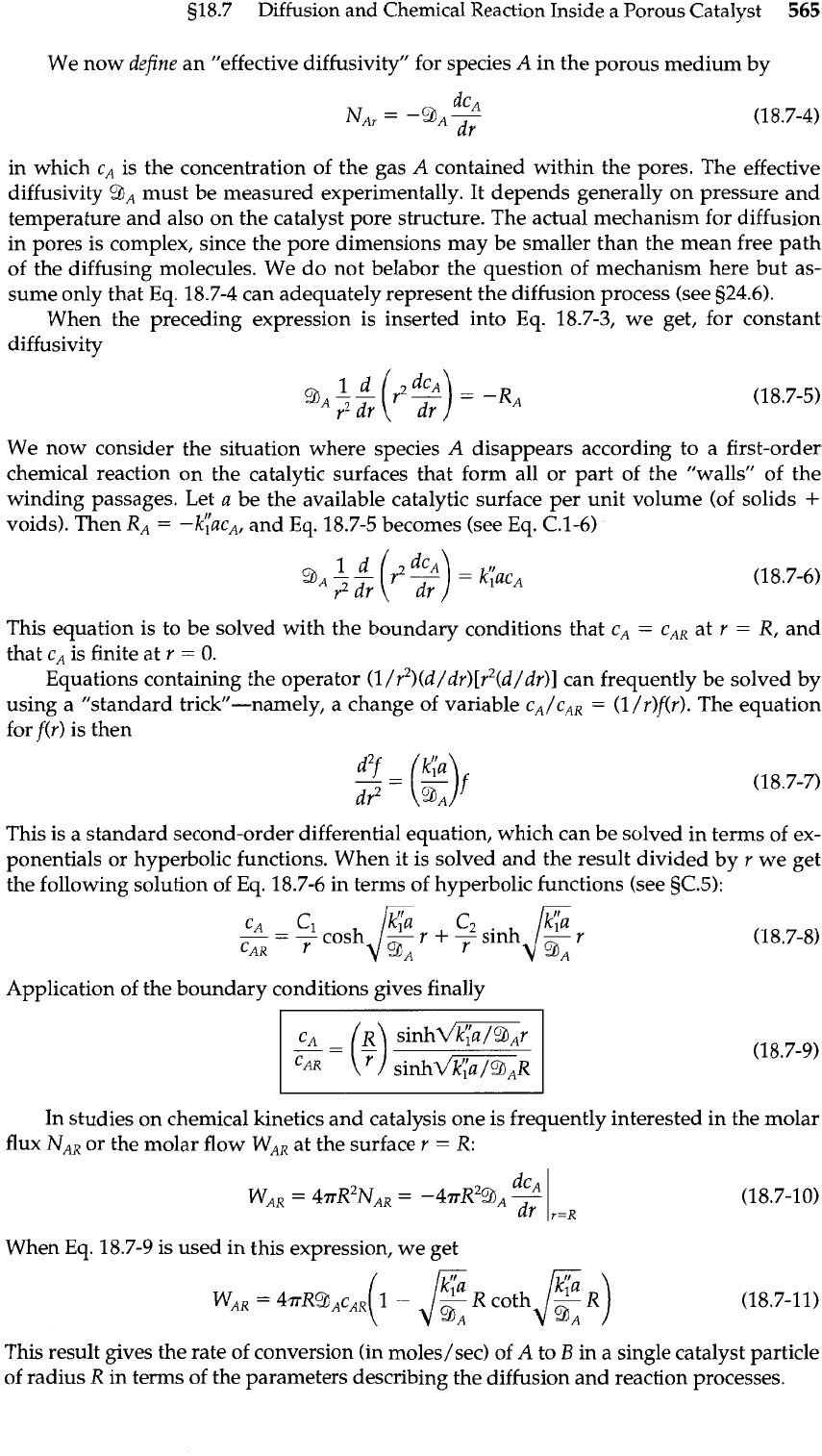
518.7
Diffusion and Chemical Reaction Inside a Porous Catalyst
565
We now
define
an "effective diffusivity" for species
A
in the porous medium by
in which cA is the concentration of the gas
A
contained within the pores. The effective
diffusivity
9,
must be measured experimentally. It depends generally on pressure and
temperature and also on the catalyst pore structure. The actual mechanism for diffusion
in pores is complex, since the pore dimensions may be smaller than the mean free path
of the diffusing molecules. We do not belabor the question of mechanism here but as-
sume only that
Eq.
18.7-4 can adequately represent the diffusion process (see 524.6).
When the preceding expression is inserted into
Eq.
18.7-3, we get, for constant
diffusivity
We now consider the situation where species
A
disappears according to a first-order
chemical reaction on the catalytic surfaces that form all or part of the "walls" of the
winding passages. Let a be the available catalytic surface per unit volume (of solids
+
voids). Then
RA
=
-k','acA, and Eq. 18.7-5 becomes (see Eq. C.l-6)
This equation is to be solved with the boundary conditions that cA
=
cA, at r
=
R,
and
that cA is finite at r
=
0.
Equations containing the operator (1/r2)(d/dr)[r2(d/dr)l can frequently be solved by
using a "standard trick-namely, a change of variable cA/cA,
=
(1
/r)f(r). The equation
for f(r) is then
This is a standard second-order differential equation, which can be solved in terms of ex-
ponential~ or hyperbolic functions. When it is solved and the result divided by
r
we get
the following solution of Eq. 18.7-6 in terms of hyperbolic functions (see 5C.5):
Application of the boundary conditions gives finally
In studies on chemical kinetics and catalysis one is frequently interested in the molar
flux
NAX
or the molar flow
WAR
at the surface r
=
R:
When Eq. 18.7-9 is used in this expression, we get
This result gives the rate of conversion (in moles/sec) of
A
to
B
in a single catalyst particle
of radius
R
in terms of the parameters describing the diffusion and reaction processes.
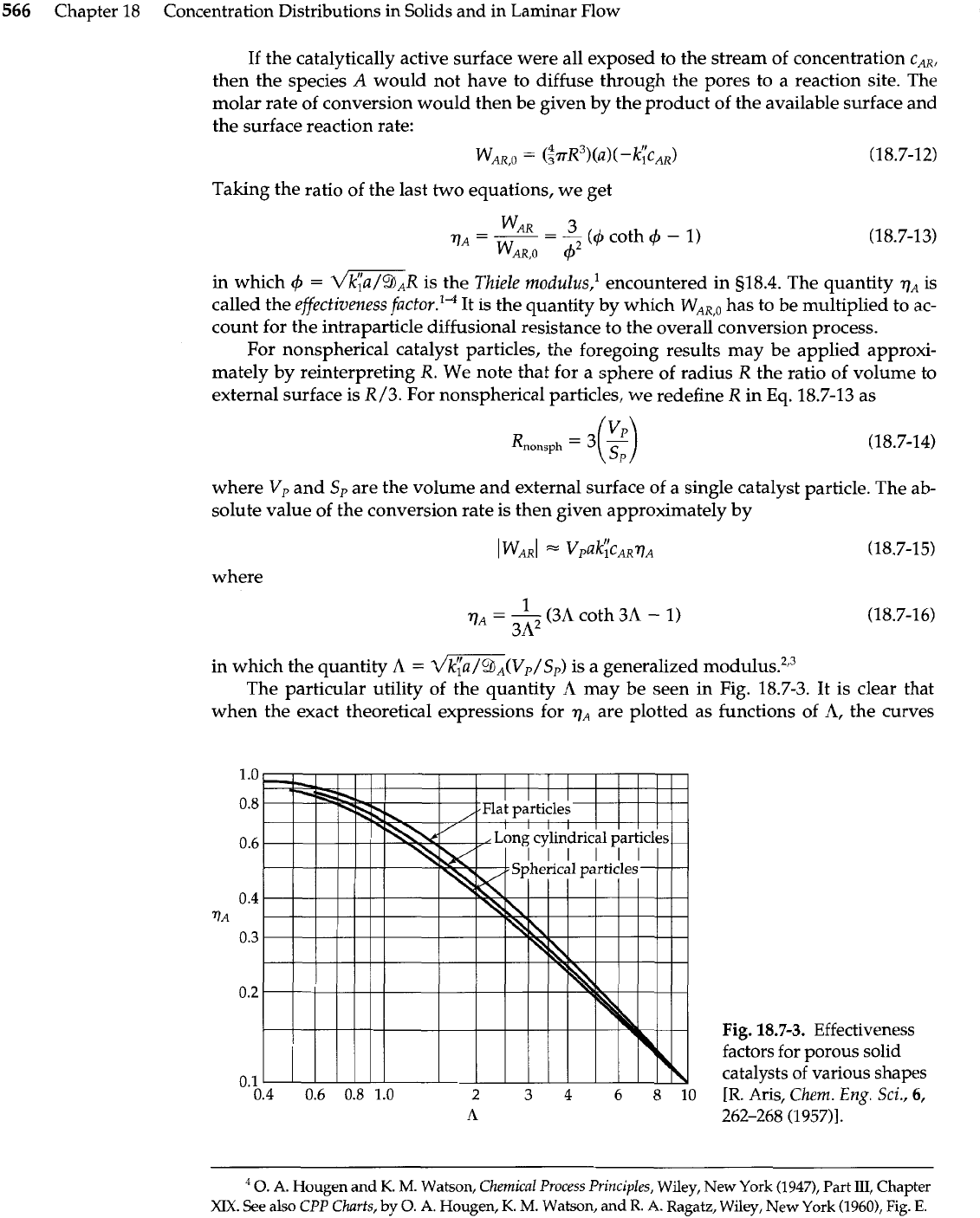
566
Chapter
18
Concentration Distributions in Solids and in Laminar Flow
If the catalytically active surface were all exposed to the stream of concentration c,,,
then the species
A
would not have to diffuse through the pores to a reaction site. The
molar rate of conversion would then be given by the product of the available surface and
the surface reaction rate:
WAR,,
=
($d3)(a)(
-k;cAR> (18.7-12)
Taking the ratio of the last two equations, we get
TIA=-=-(4
W~R
coth
4
-
1)
w~~,~
42
in which
4
=
-R
is the Thiele modulus,l encountered in s18.4. The quantity 7, is
called the efectiveness factor.'-4 It is the quantity by which
WAR,,
has to be multiplied to ac-
count for the intraparticle diffusional resistance to the overall conversion process.
For nonspherical catalyst particles, the foregoing results may be applied approxi-
mately by reinterpreting
R.
We note that for a sphere of radius
R
the ratio of volume to
external surface is
R/3.
For nonspherical particles, we redefine
R
in
Eq.
18.7-13 as
where Vp and
S,
are the volume and external surface of a single catalyst particle. The ab-
solute value of the conversion rate is then given approximately by
in which the quantity
A
=
-(V,/S,)
is a generalized mod~lus.~,~
The particular utility of the quantity
A
may be seen in Fig. 18.7-3. It is clear that
when the exact theoretical expressions for
17,
are plotted as functions of
A,
the curves
Fig.
18.7-3.
Effectiveness
factors for porous solid
catalysts of various shapes
[R.
Aris,
Chem.
Eng.
Sci.,
6,
%.
A.
Hougen and
K.
M.
Watson,
Chemical
Process
Principles,
Wiley, New York
(1947),
Part
111,
Chapter
XU(.
See
also
CPP Charts,
by
0.
A.
Hougen,
K.
M.
Watson, and
R.
A.
Ragatz, Wiley, New York
(1960),
Fig.
E.
